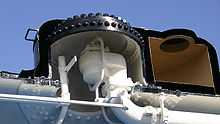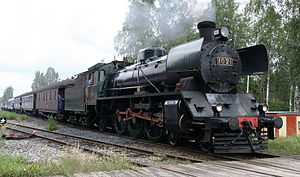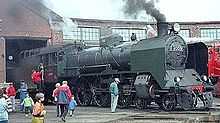VR Class Hr1
| VR Class Hr1 | |
|---|---|
|
Hr1 1021 with Witte-type smoke deflectors | |
| Type and origin | |
| Power type | Steam |
| Builder | Lokomo Oy and Tampella Oy |
| Build date | 1937–1957 |
| Total produced | 22 |
| Specifications | |
| AAR wheel arr. | 4-6-2 |
| Gauge | 1,524 mm (5 ft) |
| Driver diameter | 1,900 mm (6 ft 3 in) |
| Length | 22.2 m (72 ft 10 in) |
| Locomotive weight | 155 tonnes (153 long tons; 171 short tons) with tender |
| Boiler pressure | 15 bar (1,500 kPa; 220 psi) |
| Cylinders | Two, outside |
| Performance figures | |
| Maximum speed | 110 km/h (68 mph) |
| Tractive effort | 114 kN (25,630 lbf) |
| Career | |
| Operator(s) | VR |
| First run | 1937 |
| Withdrawn | 1974; Not in service 1972; Returned to Service due to oil crisis |
| Disposition | two restored, five scrapped, others preserved |
Hr1 class (original classification P1) was the largest passenger express steam locomotive built in Finland. Twenty-two were built between the years 1937–1957. They were numbered 1000–1021
In the thirties there was a need for faster and heavier express trains in Finland, and the Hv1–Hv3 classes were not powerful enough to fill the need. Lokomo Oy in Tampere built first two prototypes, and after successful trials 20 more were built. Most of the locomotives were fitted with Wagner-type smoke deflectors, but the last two, which were equipped with roller bearings, had Witte-type deflectors.
The nickname of the locomotive was "Ukko-Pekka" meaning approximately "(respected) Grandpa Pekka", after the President of Finland Pehr Evind Svinhufvud.
The Hr1 was built for coal firing, but during the coal shortage after the war in 1945, birch wood was used as fuel. Larger chimneys needed for extinguishing wood sparks were temporarily fitted.
The Hr1s were the most important express steam locomotive and could justifiably be called the "flagships" of VR up until 1963, when diesel locomotives started to replace steam. Their use ended officially in 1971, but two roller bearing Hr1s were returned for a short use in spring 1974.
Hr1's sister locomotive was the Tr1 class, otherwise similar, but with 2-8-2 wheel arrangement and smaller diameter drivers for cargo train use.
Preservation
The following are preserved:
- 1000 Haapamäki
- 1001 Hyvinkää
- 1002–1005 Haapamäki
- 1008 Acton, Suffolk, England
- 1009 Riihimäki
- 1010 Haapamäki
- 1011 Otanmäki
- 1012 Haapamäki
- 1014 Haapamäki
- 1016 named "Lady Patricia" on a Private Railway near Windsor, Berkshire, United Kingdom
- 1019, 1020 Haapamäki
- 1021 Riihimäki
Gallery
-
.jpg)
Hr1 1002 at Haapamaki
-
.jpg)
Hr1 1003 at Haapamaki
-
.jpg)
Hr1 1003 at Haapamaki
-

Hr1 1003 at Haapamaki
-

A 1944 Postage stamp depicting a Finnish train with a steam locomotive; the nickname of this heavy locomotive was "Ukko-Pekka"
See also
- Finnish Railway Museum
- VR Group
- List of Finnish locomotives
- List of railway museums Worldwide
- Heritage railways
- List of heritage railways
- Restored trains
- Jokioinen Museum Railway
- History of rail transport in Finland
- VR Class Pr1
- VR Class Tk3
- VR Class Hr11
External links
-
 Media related to VR Class Hr1 at Wikimedia Commons
Media related to VR Class Hr1 at Wikimedia Commons - 1016 "Lady Patricia" on her test run 28 June 2013
| ||||||||||||||||||||||||||

